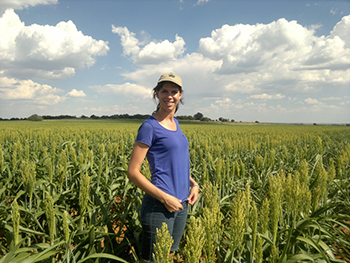Latest News Archive
Please select Category, Year, and then Month to display items
14 May 2024
|
Story ANTHONY MTHEMBU
|
Photo Supplied
 Contemporary artist Ibrahim Mahama engaging with students during his visit to the Department of Fine Arts at the University of the Free State (UFS).
Contemporary artist Ibrahim Mahama engaging with students during his visit to the Department of Fine Arts at the University of the Free State (UFS).
Ghanaian contemporary artist, Ibrahim Mahama, visited the Department of Fine Arts at the University of the Free State (UFS) to share insights with staff and students during his stay in the country.
Dr Adelheid Von Maltitz, Senior Lecturer in the Department of Fine Arts at the UFS, highlighted the significance of Mahama’s visit which took place from 21 to 28 March 2024, marking the first instance of such interaction between a Fine Arts department in South Africa and Mahama. She remarked, “It is truly astounding that a person of his calibre dedicated time to focus on our department, and I believe this has catalysed a positive shift within our department.”
Mahama’s impactful presence at UFS
Dr Von Maltitz emphasised that Mahama’s visit aimed to offer staff and students a glimpse into his artistic process and mindset. During his time at the UFS, Mahama, who was virtually overseeing his latest recent large-scale artwork titled Purple Hibiscus, which involved wrapping the Barbican Centre in London, engaged extensively with staff and students from the department about their research. He shared insights into his creative journey, presented select works, and conducted critique sessions with fourth year and postgraduate students, among other activities. Dr Von Maltitz believes this interaction, particularly with students, has significantly bolstered their confidence as aspiring artists, preparing them for professional endeavours.
Broader implications and future prospects
Mahama’s visit not only energised the department’s academic environment but also holds broader implications. Dr Von Maltitz asserted that it will solidify the department’s identity nationally and create avenues for students to pursue residencies in countries like Ghana. Therefore, maintaining a fruitful relationship with Mahama remains a priority for the department.
Reflecting on the visit Dr Von Maltitz concluded, ‘’the key takeaway, especially for the students, was witnessing the potential of their works within the broader South African and international contexts. “
Researcher works on finding practical solutions to plant diseases for farmers
2017-10-03

Lisa Ann Rothman, researcher in the Department of
Plant Sciences.
Photo: Supplied
Plant disease epidemics have wreaked havoc for many centuries. Notable examples are the devastating Great Famine in Ireland and the Witches of Salem.
Plant diseases form, due to a reaction to suitable environments, when a susceptible host and viable disease causal organism are present. If the interactions between these three factors are monitored over space and time the outcome has the ability to form a “simplification of reality”. This is more formally known as a plant disease model. Lisa Ann Rothman, a researcher in the Department of Plant Sciences at the University of the Free State (UFS) participated in the Three Minute Thesis competition in which she presented on Using mathematical models to predict plant disease.
Forecast models provide promise fighting plant diseases
The aim of Lisa’s study is to identify weather and other driving variables that interact with critical host growth stages and pathogens to favour disease incidence and severity, for future development of risk forecasting models. Lisa used the disease, sorghum grain mold, caused by colonisation of Fusarium graminearum, and concomitant mycotoxin production to illustrate the modelling process.
She said: “Internationally, forecasting models for many plant diseases exist and are applied commercially for important agricultural crops. The application of these models in a South African context has been limited, but provides promise for effective disease intervention technologies.
Contributing to the betterment of society
“My BSc Agric (Plant Pathology) undergraduate degree was completed in combination with Agrometeorology, agricultural weather science. I knew that I wanted to combine my love for weather science with my primary interest, Plant Pathology.
“My research is built on the statement of Lord Kelvin: ‘To measure is to know and if you cannot measure it, you cannot improve it’. Measuring the changes in plant disease epidemics allows for these models to be developed and ultimately provide practical solutions for our farmers. Plant disease prediction models have the potential ability to reduce the risk for famers, allowing the timing of fungicide applications to be optimised, thus protecting their yields and ultimately their livelihoods. I am continuing my studies in agriculture in the hope of contributing to the betterment of society.”